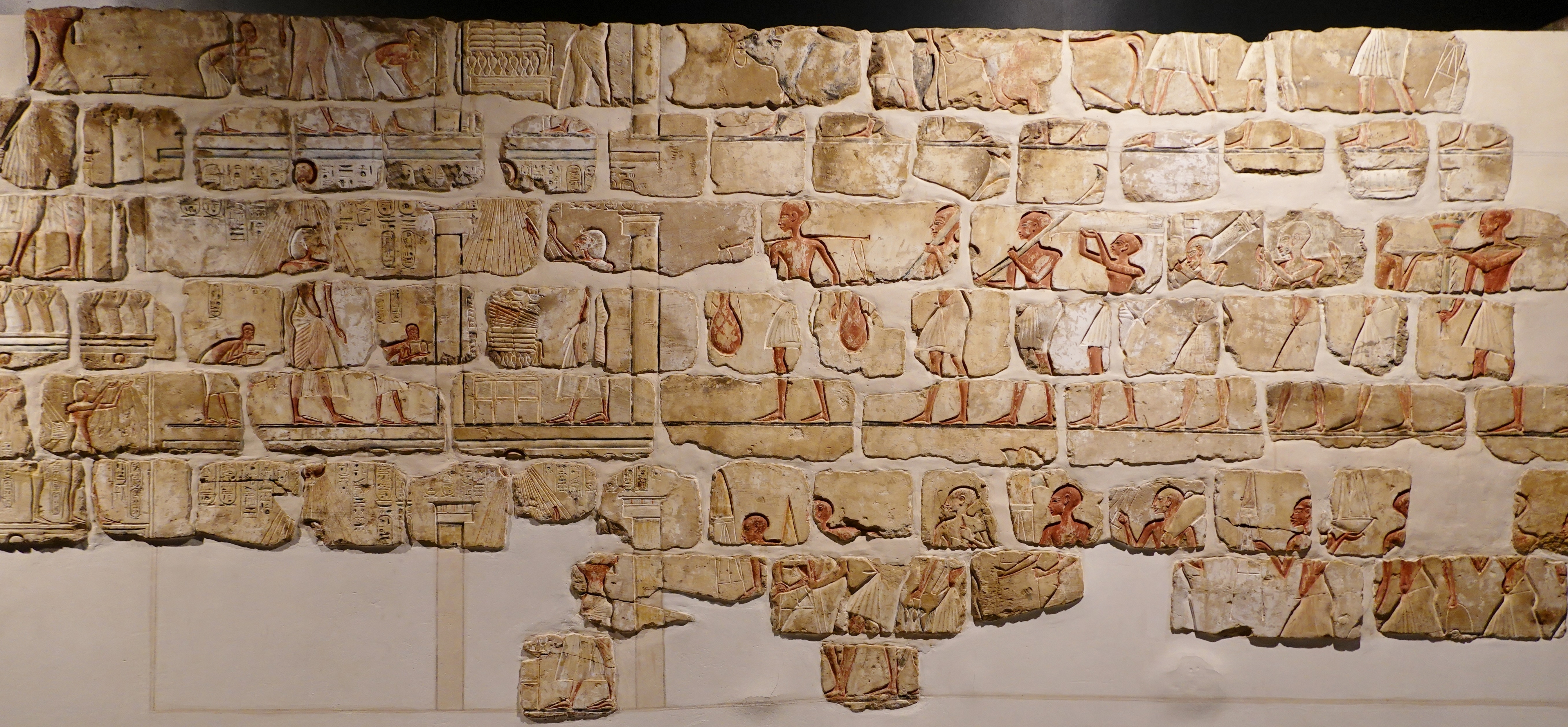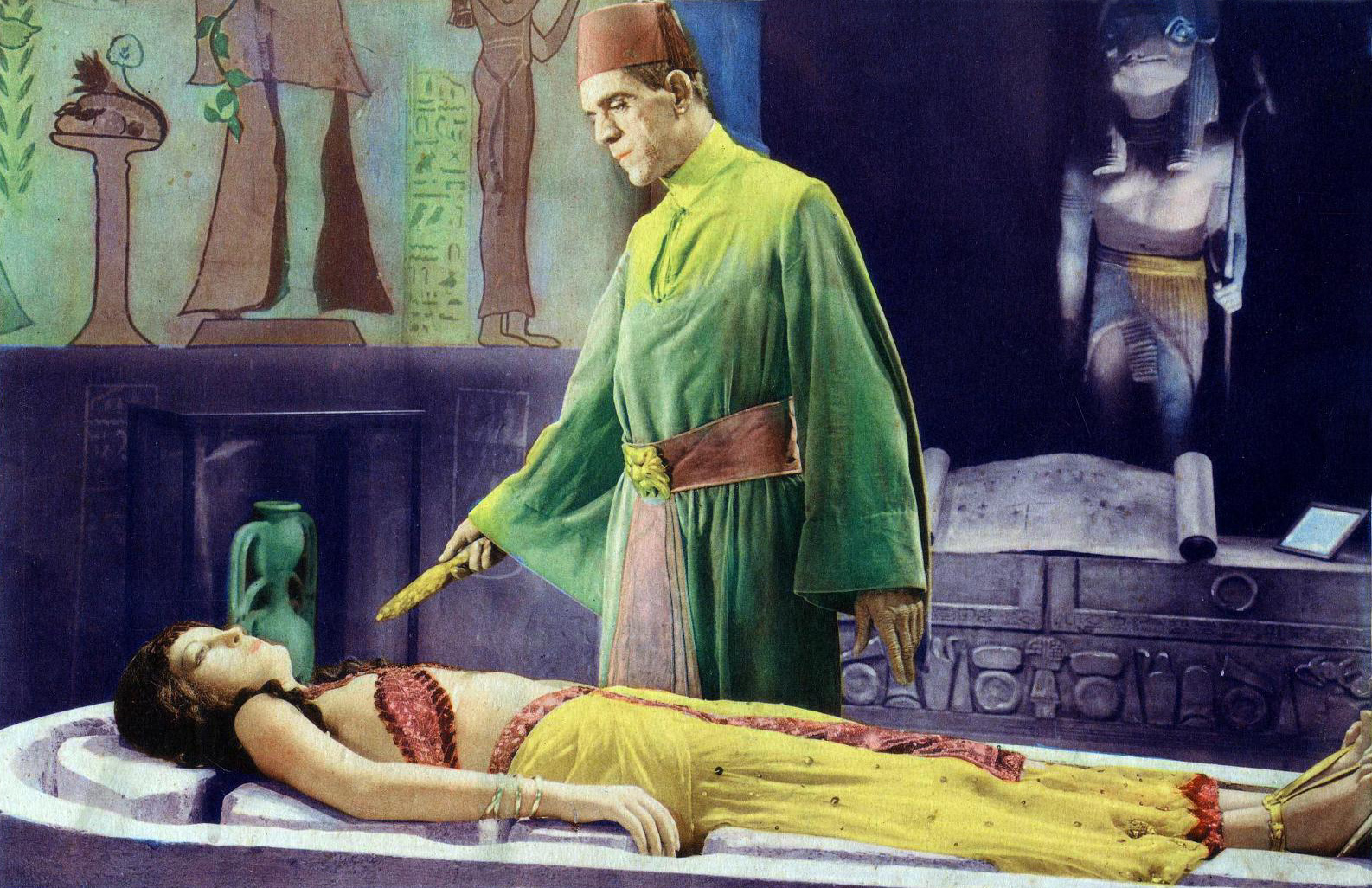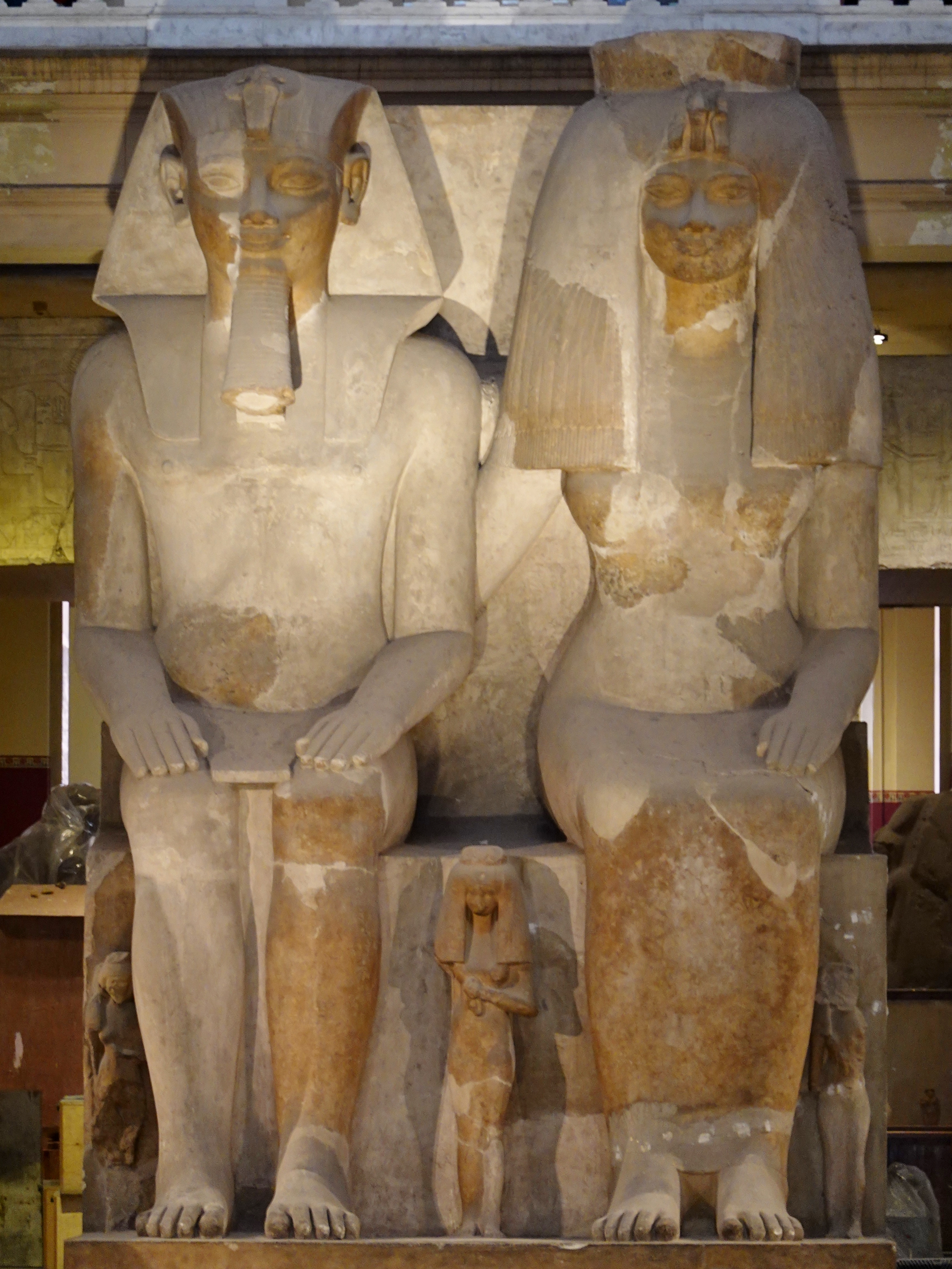|
Ankhesenpaaten Tasherit
Ankhesenpaaten Tasherit (or Ankhesenpaaten-ta-sherit, “Ankhesenpaaten the Younger”) was an ancient Egyptian princess of the 18th Dynasty. Ankhesenpaaten Tasherit and another princess, Meritaten Tasherit are two princesses who appear in scenes dating to the later part of the reign of Akhenaten. The titles of at least one of the princess is of the form " ..-taherit, born of .. born of the King's Great Wife .. The inscription is damaged and the name of the mother and grandmother of the princesses has not been preserved.Dodson, Aidan, Amarna Sunset: Nefertiti, Tutankhamun, Ay, Horemheb, and the Egyptian Counter-Reformation. The American University in Cairo Press. 2009, Tyldesley, Joyce. Nefertiti: Egypt's Sun Queen. Penguin. 1998. , pp 168, 173 Ankhesenpaaten Tasherit has been known to archaeologists since 1938, when a talatat block with her picture and name was found in Hermopolis. Proposed parents Several different sets of parents have been proposed for Ankhesenpaaten Tasheri ... [...More Info...] [...Related Items...] OR: [Wikipedia] [Google] [Baidu] |
Meritaten Tasherit
Meritaten Tasherit, which means ''Meritaten the Younger'' was an ancient Egyptian princess of the 18th Dynasty. She is likely to have been the daughter of Meritaten, eldest daughter of Pharaoh Akhenaten. Who her father was remains a matter of debate. Many assume it to be Meritaten's father, Akhenaten, or possibly her husband Smenkhkare. Since both Meritaten Tasherit and another princess, Ankhesenpaaten Tasherit appear only in texts that once mentioned Akhenaten's second wife Kiya, it is also possible that they were children of Akhenaten and Kiya, or that they were fictional, replacing the name of Kiya's daughter, who might have been Beketaten, more commonly thought to be Tiye's child. Meritaten Tasherit's fate is uncertain. The mention of the god Aten in her name suggests that she was indeed a daughter of Akhenaten, since his successors reverted his religious reforms, and reverted to the worship of Egypt Egypt ( ar, مصر , ), officially the Arab Republic of Egypt, is a ... [...More Info...] [...Related Items...] OR: [Wikipedia] [Google] [Baidu] |
Akhenaten
Akhenaten (pronounced ), also spelled Echnaton, Akhenaton, ( egy, ꜣḫ-n-jtn ''ʾŪḫə-nə-yātəy'', , meaning "Effective for the Aten"), was an ancient Egyptian pharaoh reigning or 1351–1334 BC, the tenth ruler of the Eighteenth Dynasty. Before the fifth year of his reign, he was known as Amenhotep IV ( egy, jmn-ḥtp, links=no, meaning " Amun is satisfied", Hellenized as ''Amenophis IV''). As a pharaoh, Akhenaten is noted for abandoning Egypt's traditional polytheism and introducing Atenism, or worship centered around Aten. The views of Egyptologists differ as to whether the religious policy was absolutely monotheistic, or whether it was monolatry, syncretistic, or henotheistic. This culture shift away from traditional religion was reversed after his death. Akhenaten's monuments were dismantled and hidden, his statues were destroyed, and his name excluded from lists of rulers compiled by later pharaohs. Traditional religious practice was gradually resto ... [...More Info...] [...Related Items...] OR: [Wikipedia] [Google] [Baidu] |
Talatat
Talatat are limestone blocks of standardized size (c. 27 by 27 by 54 cm, corresponding to by by 1 ancient Egyptian cubits) used during the 18th Dynasty reign of the Pharaoh Akhenaten in the building of the Aton temples at Karnak and Akhetaten (modern Amarna). The standardized size and their small weight made construction more efficient. Their use may have begun in the second year of Akhenaten's reign. After the Amarna Period talatat construction was abandoned, apparently not having withstood the test of time. Amenhotep IV talatats The blocks used in the Temple of Amenhotep IV in Karnak, and the other abandoned temples devoted to the deity Aten, were reused by Horemheb and Ramesses II as filler material for pylons and as foundations for large buildings. The Great Hypostyle Hall at Karnak is built on thousands of these blocks, as is the Second Pylon. Tens of thousands of the talatat have been recovered. The decorated stones are being photographed and the scenes they depict a ... [...More Info...] [...Related Items...] OR: [Wikipedia] [Google] [Baidu] |
Hermopolis
Hermopolis ( grc, Ἑρμούπολις ''Hermoúpolis'' "the City of Hermes", also ''Hermopolis Magna'', ''Hermoû pólis megálẽ'', egy, ḫmnw , Egyptological pronunciation: "Khemenu"; cop, Ϣⲙⲟⲩⲛ ''Shmun''; ar, الأشمونين) was a major city in antiquity, located near the boundary between Lower and Upper Egypt. A provincial capital since the Old Kingdom of Egypt, Hermopolis developed into a major city of Roman Egypt, and an early Christian center from the third century. It was abandoned after the Muslim conquest but was restored as both a Latin Catholic (meanwhile suppressed) and a Coptic Orthodox titular see. Its remains are located near the modern town of el Ashmunein (from the Coptic name) in Mallawi, Minya Governorate, Egypt. Name ''Khemenu'' ('), the Egyptian language name of the city, means "Eight-Town", after the Ogdoad, a group of eight "primordial" deities whose cult was situated there. The name survived as Coptic ''Shmun'', from wh ... [...More Info...] [...Related Items...] OR: [Wikipedia] [Google] [Baidu] |
Ankhesenamun
Ankhesenamun (, "Her Life Is of Amun"; c. 1348 or c. 1342 – after 1322 BC) was a queen who lived during the 18th Dynasty of Egypt as the pharaoh Akhenaten's daughter and subsequently became the Great Royal Wife of pharaoh Tutankhamun. Born Ankhesenpaaten (, "she lives for the Aten"), she was the third of six known daughters of the Egyptian Pharaoh Akhenaten and his Great Royal Wife Nefertiti. She became the Great Royal Wife of Tutankhamun. The change in her name reflects the changes in ancient Egyptian religion during her lifetime after her father's death. Her youth is well documented in the ancient reliefs and paintings of the reign of her parents. The mummy of Tutankhamun's mother has been identified through DNA analysis as a full sister to his father, the unidentified mummy found in tomb KV55, and as a daughter of his grandfather, Amenhotep III. So far his mother's name is uncertain, but her mummy is known informally to scientists as the Younger Lady. Ankhesenamun was we ... [...More Info...] [...Related Items...] OR: [Wikipedia] [Google] [Baidu] |
Nefertiti
Neferneferuaten Nefertiti () ( – c. 1330 BC) was a queen of the 18th Dynasty of Ancient Egypt, the great royal wife of Pharaoh Akhenaten. Nefertiti and her husband were known for a radical change in national religious policy, in which they promoted a form of proto- monotheism centred on the sun god Aten. With her husband, she reigned at what was arguably the wealthiest period of ancient Egyptian history. Some scholars believe that Nefertiti ruled briefly as Neferneferuaten after her husband's death and before the ascension of Tutankhamun, although this identification is Neferneferuaten#Nefertiti, a matter of ongoing debate.Dodson, Aidan, Amarna Sunset: ''Nefertiti, Tutankhamun, Ay, Horemheb, and the Egyptian Counter-Reformation''. The American University in Cairo Press. 2009, . If Nefertiti did rule as Pharaoh, her reign was marked by the fall of Amarna and relocation of the capital back to the traditional city of Thebes, Egypt, Thebes. She was made famous by Nefe ... [...More Info...] [...Related Items...] OR: [Wikipedia] [Google] [Baidu] |
Kiya
Kiya was one of the wives of the Egyptian Pharaoh Akhenaten. Little is known about her, and her actions and roles are poorly documented in the historical record, in contrast to those of Akhenaten's ‘Great royal wife’, Nefertiti. Her unusual name suggests that she may originally have been a Mitanni princess.Reeves, C. Nicholas. ''New Light on Kiya from Texts in the British Museum'', p.100 The Journal of Egyptian Archaeology, Vol. 74 (1988) Surviving evidence demonstrates that Kiya was an important figure at Akhenaten's court during the middle years of his reign, when she had a daughter with him.William J. Murnane. ''Texts from the Amarna Period in Egypt.'' Edited by E.S. Meltzer. Atlanta: Society of Biblical Literature, 1995. () Page 9, pp 90–93, pp 210–211.Aidan Dodson. Amarna Sunset: Nefertiti, Tutankhamun, Ay, Horemheb, and the Egyptian Counter Reformation. The American University in Cairo Press, 2009. () Page 17. She disappears from history a few years before her royal h ... [...More Info...] [...Related Items...] OR: [Wikipedia] [Google] [Baidu] |
Beketaten
Beketaten ( egy, bꜣk.t-itn)(14th century BCE) was an ancient Egyptian princess of the 18th Dynasty. Beketaten is considered to be the youngest daughter of Pharaoh Amenhotep III and his Great Royal Wife Tiye, thus the sister of Pharaoh Akhenaten.Aidan Dodson & Dyan Hilton, The Complete Royal Families of Ancient Egypt, Thames & Hudson (2004), p.154 Her name means "Handmaid of Aten". Family Beketaten was most likely the youngest daughter of Amenhotep III and Tiye. This would mean their other children were her siblings, including Prince Thutmose, the Pharaoh Akhenaten, Sitamun, Isis, Henuttaneb, and Nebetah. Some scholars have speculated that Nebetah was identical with Beketaten. However, no evidence proves that they are the same person. It has also been suggested that she might be the daughter of Akhenaten and his secondary wife, Kiya. Kiya is shown on a few occasions with a princess whose name ends in -''aten''. However, the full name of the princess has been lost. It has b ... [...More Info...] [...Related Items...] OR: [Wikipedia] [Google] [Baidu] |
Tiye
Tiye (c. 1398 BC – 1338 BC, also spelled Tye, Taia, Tiy and Tiyi) was the daughter of Yuya and Thuya. She became the Great Royal Wife of the Ancient Egypt, Egyptian pharaoh Amenhotep III. She was the mother of Akhenaten and grandmother of Tutankhamun. In 2010, DNA analysis confirmed her as the mummy known as "The Elder Lady" found in the tomb of Amenhotep II (KV35) in 1898. Family and early life Tiye's father, Yuya, was a non-royal, wealthy landowner from the Upper Egyptian town of Akhmim, where he served as a priest and superintendent of oxen or commander of the chariotry. Tiye's mother, Thuya, was involved in many religious cults, as her different titles attested (''Singer of Hathor'', ''Chief of the Entertainers'' of both Amun and Min (god), Min...), which suggests that she was a member of the royal family. Egyptologists have suggested that Tiye's father, Yuya, was of foreign origin due to the features of his mummy and the many different spellings of his name, which mig ... [...More Info...] [...Related Items...] OR: [Wikipedia] [Google] [Baidu] |
UPublish
Universal Publishers is the parent publishing company of three non-fiction book imprints specializing in nonfiction, how-to, technical and academic titles (Universal-Publishers, BrownWalker Press & Dissertation.com). It originally began in 1997 as "Dissertation.com," one of the first companies to use print on-demand and PDF (Portable Document Format) e-book technologies to publish academic theses and Ph.D. dissertations for sale online. The company was founded by Jeffrey R. Young, while he was in graduate school as a way to make academic dissertations widely available to other students and researchers at a reasonable price. The ''BrownWalker Press'' imprint was launched in 2001 to publish academic textbooks, scholarly monographs, and edited collections across a wide range of academic expertise. In 2010, BrownWalker Press added an academic conference proceeding publishing division (ConferencePaper Publisher). Universal Publishers has over 1500 nonfiction, how-to , and academic t ... [...More Info...] [...Related Items...] OR: [Wikipedia] [Google] [Baidu] |





